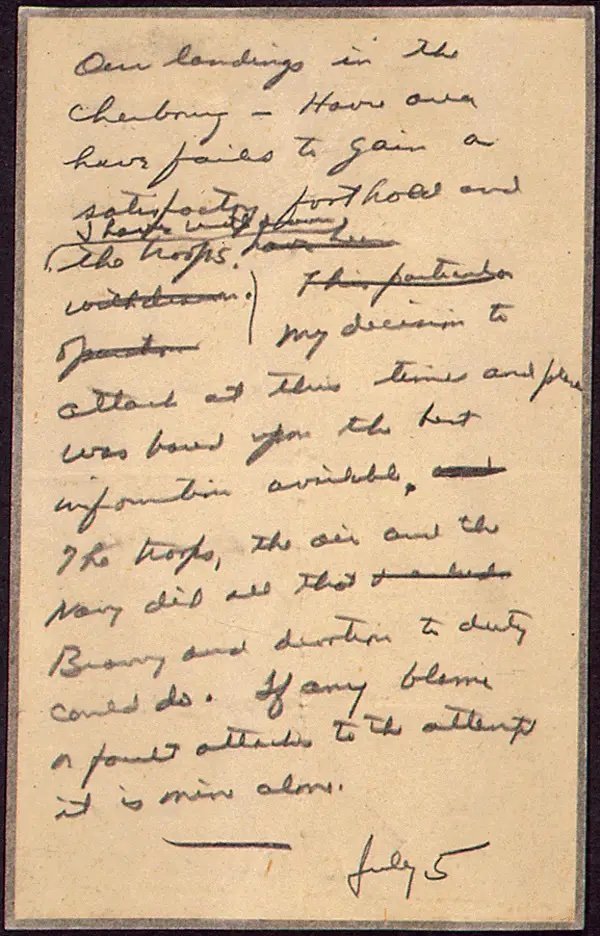The D-Day Decision (#265)
Today’s post covers another aspect of the D-Day invasion -- the decision by General Dwight D. Eisenhower to launch the invasion of Normandy.
This year, I am doing a series on leaders and leadership in the European Theater of Operations (ETO) in World War II. This is 14th in the series. Check out the blog to see them all or go to the links at the bottom of this article to see the most recent ones.
The D-Day Decision
As D-Day approached, the English Channel was subject to the worst storms in nearly a century, and General Dwight Eisenhower, the Supreme Commander, Allied Expeditionary Force, postponed the date of the invasion until Tuesday, June 6, 1944. In selecting a time for the invasion, the D-Day decision had to be made 36 hours in advance to load the troops on the ships, assemble the invasion fleet, and deploy the airborne troops to airfields. Failing to launch the invasion by June 6th would result in postponement another two weeks until there were favorable tides and a moon. The clock was ticking and the weather was not cooperating.
In the late evening of June 4, Eisenhower assembled his commanders and staff at Southwick House, near Portsmouth. The group met in the former library of the house around a large wooden table. His meteorological officer predicted a temporary break in the weather on the morning of June 6. Field Marshal Bernard Montgomery urged that the assault go forward. Leigh-Mallory, Eisenhower’s air commander, however, recommended against launching the invasion due to his fear of casualties. Admiral Bertram Ramsey, the sea commander, stated that if the invasion was to commence that he needed to know immediately to organize and launch the fleet. The decision to go or not to go firmly rested on Eisenhower’s shoulders. Ike agreed to launch the slower moving ships and meet again in a couple of hours to make the final decision. Eisenhower then went back to his trailer and tried to sleep.
He reconvened the team at 3:30 AM on June 5th in the Southwick House. As Ike walked back to the main house, the rain continued to fall. After carefully considering all the intelligence, the weather predictions, and all the recommendations from his commanders, Eisenhower stood up and began walking back and forth, pondering the most important decision of his life and the fate of millions. It was now up to him. Only he could make the decision. He kept pacing, hands clasped behind his back, chin on his chest. and then he stopped. The tension left his face. He looked up at his commanders and announced his fateful decision, “Okay, we’ll go.”
The commanders and staff quickly left the library to put the invasion into motion. Only Ike and the weatherman were left. With a big smile, Eisenhower turned to him and said, “Don’t bring me any more bad news.”
Extreme Ownership
Extreme ownership is a concept popularized by US Navy SEAL Jocko Willink. Extreme ownership is the practice of owning everything in your world, to an extreme degree. It means you are responsible for not just those tasks which you directly control, but for all those tasks that impact whether your mission is successful. General Eisenhower possessed extreme ownership. After making the decision to launch the invasion, he took a piece of paper and wrote a note that he tucked away in his wallet. His valet found the note a month later and kept it. As you read it, think about the thoughts and emotions that were running through his mind. Eisenhower wrote:
Our landings in the Cherbourg-Havre area have failed to gain a satisfactory foothold and I have withdrawn the troops. My decision to attack at this time and place was based upon the best information available. The troops, the air and the navy did all that bravery and devotion to duty could do. If any blame or fault attaches to the attempt it is mine alone.
July 5 (misdated by DDE)
Eisenhower’s Note on D-Day
His Chief of Staff, Lieutenant General Walter Bedell Smith, recognized Ike’s immense responsibilities by saying, “I never realized before the loneliness and isolation of a commander at a time when such a momentous decision has to be taken, with the full knowledge that failure or success rests on his judgment alone.” Dwight Eisenhower rose to the occasion and demonstrated extreme ownership and incredible character.
Conclusion
The last five blog posts on leaders and leadership from the World War II European Theater of Operations are:
Interested in bringing your team to Leadership Experience that uses historic case studies, like General Eisenhower during D-Day to enhance your team’s leadership today? TFCG offers the D-Day, Market-Garden, and Battle of the Bulge Leadership Experiences in Europe. TFCG also offers the Eisenhower, Currahee!, the War in the Pacific Museum, and Pearl Harbor Leadership Experiences in the United States. Send me an email and we can start the discussion today about building better leaders in your organization using a historic Leadership Experience. Or click on one of the pictures to learn more about that specific program.
In the meantime, go on the offensive and use Eisenhower’s decision to launch the invasion of Normandy and his extreme ownership to inspire you in the coming weeks.

